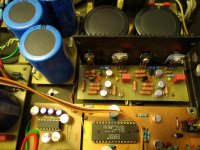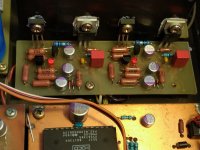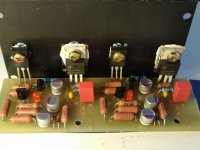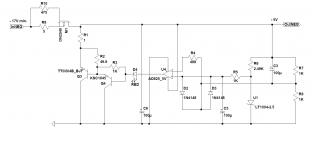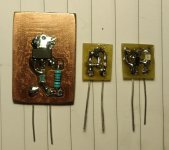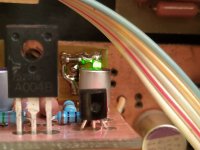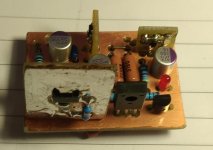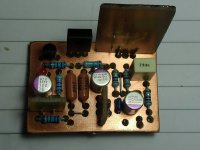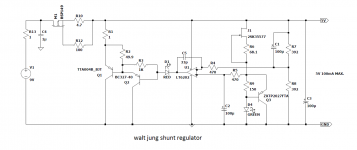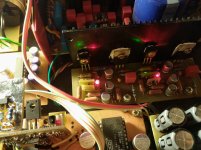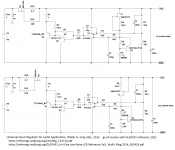These days I made a Mr.Walt Jung shunt reg, which I installed in my DAC for power supply for PCM1702. The circuit is from the WaltJung.org web site.Directory listing
For floating power supply from article I need to modify the existing power supply in the DAC so I modified the negative regulator as Improved PN Regs, inserted the NPN and turned the polarity of the diodes and references. For 5V as a reference I used the LM4040. The transistors are TTC004B / KSC1845 for N reg., TTA004B / KSA992 for P reg. and op.amp is AD825 for both. As I have excellent experiences with Walt's regulators for analog circuits, I was interested in how this regulator will behave for digital circuits.
The oscilloscope shows the difference between the old reg and this in noise reduction. There has also been a change of sound, the sound image is much more open with plenty of details and dynamics.
A really good regulator.
For floating power supply from article I need to modify the existing power supply in the DAC so I modified the negative regulator as Improved PN Regs, inserted the NPN and turned the polarity of the diodes and references. For 5V as a reference I used the LM4040. The transistors are TTC004B / KSC1845 for N reg., TTA004B / KSA992 for P reg. and op.amp is AD825 for both. As I have excellent experiences with Walt's regulators for analog circuits, I was interested in how this regulator will behave for digital circuits.
The oscilloscope shows the difference between the old reg and this in noise reduction. There has also been a change of sound, the sound image is much more open with plenty of details and dynamics.
A really good regulator.
Attachments
It kinda worries me that a very large output disturbance (on the OutNEG node) can change the VREF.
Suppose OutNEG steps-down by more than the forward voltage of diode D2. Then D2 becomes forward biased, and D2 pulls down VREF, discharging C5. Now the regulator is regulating to the wrong voltage! Oh No!
I guess the answer is, don't ask this regulator to regulate against large output disturbances. Another approach might be to modify the connections to R4.
Suppose OutNEG steps-down by more than the forward voltage of diode D2. Then D2 becomes forward biased, and D2 pulls down VREF, discharging C5. Now the regulator is regulating to the wrong voltage! Oh No!
I guess the answer is, don't ask this regulator to regulate against large output disturbances. Another approach might be to modify the connections to R4.
It kinda worries me that a very large output disturbance (on the OutNEG node) can change the VREF.
Suppose OutNEG steps-down by more than the forward voltage of diode D2. Then D2 becomes forward biased, and D2 pulls down VREF, discharging C5. Now the regulator is regulating to the wrong voltage! Oh No!
I guess the answer is, don't ask this regulator to regulate against large output disturbances. Another approach might be to modify the connections to R4.
Mark, I don't think it is a problem as such, assuming that the large Vout disturbance only happens at overload where the reg drops out of regulation. In that case, it actually can be viewed as a sort of safety feature.
I am disappointed that he doesn't show the scope picture of the noise reduction he mentioned he has seen. So that is unsubstantiated, akin to hearsay.
Jan
Last edited:
A couple of days ago I successfully tested the LT6202 instead of the cheap AD8091 which was also tested as a cheap op.amp option.
I also inserted an SMD version of the GLED431 reference with ZXTP2027F instead of ZTX951, the reference is powered by CCS with 2SK3557 with 6mA current.
I also replaced the DN2540 with a BSP149 so there can now be a smaller voltage drop across the regulator, for 5V at the output 8V at the input is enough. The current across the BSP149 is around 130mA.
I also inserted an SMD version of the GLED431 reference with ZXTP2027F instead of ZTX951, the reference is powered by CCS with 2SK3557 with 6mA current.
I also replaced the DN2540 with a BSP149 so there can now be a smaller voltage drop across the regulator, for 5V at the output 8V at the input is enough. The current across the BSP149 is around 130mA.
Attachments
I can say that this is the best regulator I have made so far, and I made almost all of them posted on this forum, it was tested only in the digital power supply in my DAC and it turned out much better than the excellent ADM7150, it will soon have a chance to show and how it works in the analog power supply in I / V conversion for the my new DAC with SAA3570+TDA1547.
I made almost all of them posted on this forum
What do you think about Salas's R1.2 regulator when compared to Jung's? Despite of the Vref, the op amp is critical on Jung's regulator. For digital rail, I used to prefer ultra low-noise type, including low 1/f ones. Yet, it turns out higher speed has more impact on the sound. However, it's hard to make a high speed (200Mhz+) op amp running absolutely stable on my regulator (not Jung's).
Poting
Before W.J. shunt regulator for PCM1702 (+/- 5V) I had Salas shunt reg. ver 1.1, otherwise it is better than most regulators for digital rail I have tried including the classic W.J. superregulator .But W.J shunt reg. is much better in my opinion than Salas shunt.
I agree that the choice of op. amp. crucial for the quality of the regulator, the speed itself also plays a role especially with the digital rail, but I think the noise is more important. So far I have used op.amp with a bandwidth of 50MHz to 110MHz and have had no problems with W.J. regulators.The next test will be with the LT6200 which has a bandwidth of 165MHz but low V / μs (below 50) as well as the LT6202 if we compare with the AD817 which has 200V / μs at 5V but higher noise. Otherwise the AD817 works great in W.J. regulators, but the LT6202 (hopefully the LT6200 as well) opens up one new dimension.
The choice of voltage reference also plays a big role.
I agree that the choice of op. amp. crucial for the quality of the regulator, the speed itself also plays a role especially with the digital rail, but I think the noise is more important. So far I have used op.amp with a bandwidth of 50MHz to 110MHz and have had no problems with W.J. regulators.The next test will be with the LT6200 which has a bandwidth of 165MHz but low V / μs (below 50) as well as the LT6202 if we compare with the AD817 which has 200V / μs at 5V but higher noise. Otherwise the AD817 works great in W.J. regulators, but the LT6202 (hopefully the LT6200 as well) opens up one new dimension.
The choice of voltage reference also plays a big role.
Here are both versions, positive and negative for +/- 5V.
The idea with a better op.amp with less noise and better reference is from Mr. Walt Jung GLED431 article, I only added CCS for GLED and BSP149 instead of DN2540.
The idea with a better op.amp with less noise and better reference is from Mr. Walt Jung GLED431 article, I only added CCS for GLED and BSP149 instead of DN2540.
Attachments
- Home
- Amplifiers
- Power Supplies
- Shunt-type regulator from Mr. Walt Jung
